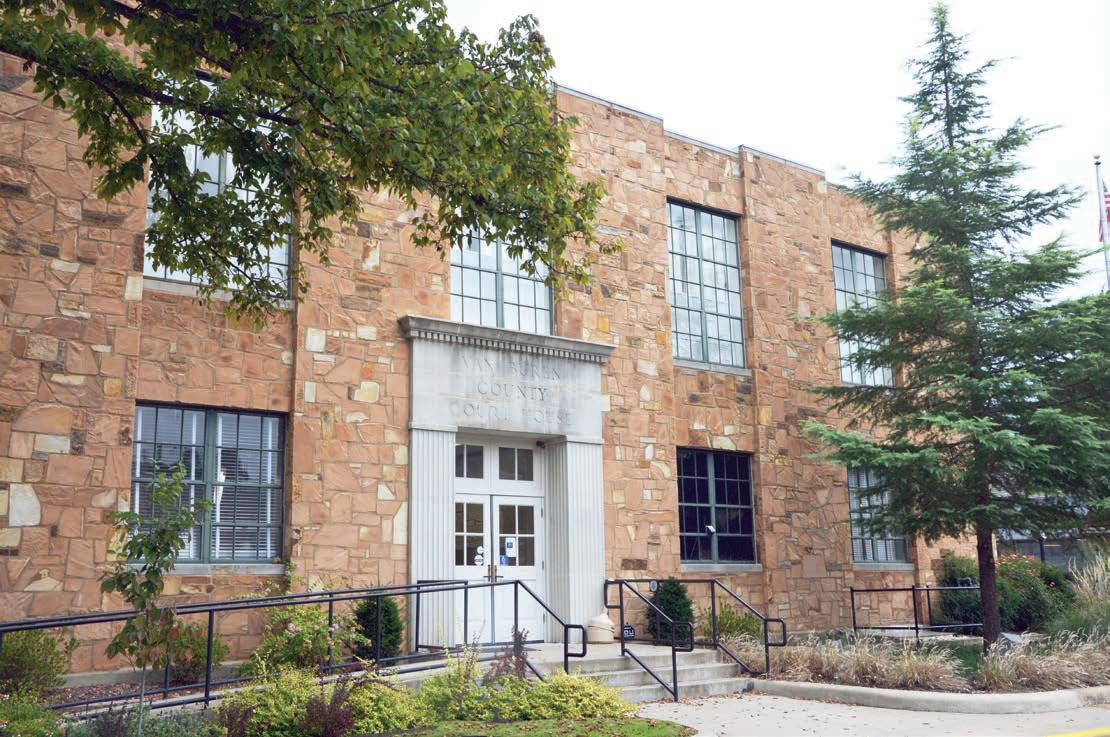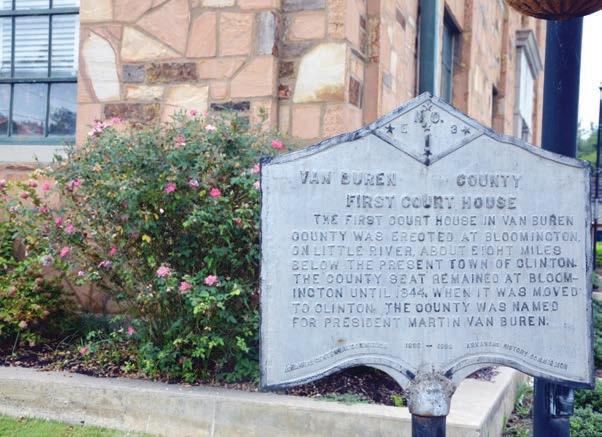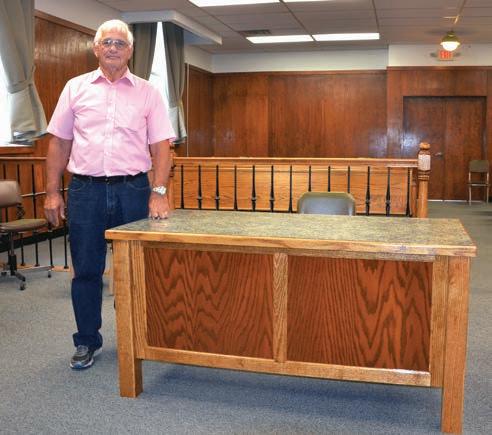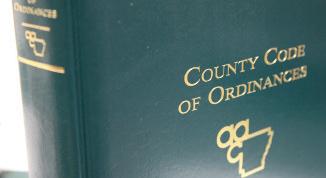
7 minute read
Small Van Buren County Courthouse serves large purpose

Small Packages
Van Buren County Courthouse may be smallest in state but it serves a large purpose
Story by Mark Christ and Photography by Holly Hope Arkansas Historic Preservation Program
While it may be the smallest county courthouse in Arkansas, the 1934 Van Buren County Courthouse remains the centerpiece of a vibrant downtown in the foothills of the Ozark Mountains in north Arkansas, and generations of caretakers have seen that it stayed that way, helped in part by the Arkansas Historic Preservation Program’s County Courthouse Restoration Grant Program, funded through Real Estate Transfer Tax proceeds administered by the Arkansas Natural and Cultural Resources Council.
The area that would become Van Buren County was a remote wilderness when Georgia native John Lafferty moved into the “Big Bottoms” where three branches of the Little Red River converged and established a farmstead during the territorial period. Lafferty lobbied hard to have a new seat of local government created to serve settlers in the area and he was successful on Nov. 11, 1833, when Van Buren County — named for Vice President Martin Van Buren — was carved from adjacent counties to serve its rugged area.
The first courthouse for the new county was established in Obadiah Marsh’s one-room log house in the Bloomington community — better known as Mudtown for the condition of its streets after a hard rain. Local men soon built a new log structure to house county government, which may have been a very popular location in that it was just across from a horse-racing track second only in size to the one at Batesville.
In 1842, the county seat was moved to Clinton, the home of Van Buren County’s first cotton gin in 1840, and another oneroom log courthouse was constructed. As settlement increased and prosperity grew, this humble structure was soon replaced by a two-story frame courthouse with a stately, columned front façade.
Van Buren County, as was the rest of Arkansas, was deeply divided over secession as Civil War loomed. Some men joined the Confederate army while others joined the Unionist “Peace Society” — many of these were later arrested and given the choice of joining the Confederate army or going to prison. As the war progressed, violence plagued the area as pro-Union “jayhawkers,” pro-Confederate “bushwhackers” and gangs of



Opposite Page: The Van Buren County Courthouse, the smallest courthouse in the state, stands as a striking example of the Art Deco style. Top Left: An historical marker notes the establishment of the first Van Buren County Courthouse in a one-room log house in the Bloomington community. Top Right: Van Buren County Circuit Clerk Ester Bass built much of the new wooden furniture in the recently refurbished courthouse.
lawless thugs battled and preyed on the local population. Bushwhackers burned the courthouse in 1865. The local Methodist Church was pressed into service as a temporary seat of justice until a new one was built — another two-story frame building constructed in 1869 that would serve until 1934, outlasting a couple of burglaries and a pair of arson attempts.
Economic disaster hit Van Buren County hard during the Great Depression, and local leaders turned to one of President Franklin Delano Roosevelt’s New Deal agencies to replace the aging courthouse in Clinton. The Federal Emergency Administration of Public Works (soon known as the Public Works Administration, or PWA) was created in 1933 to help fund local public construction and infrastructure projects. The administration of County Judge John H. Johnson was successful in procuring PWA funding for a new building for county business.
Little Rock architects Frank Erhart and Howard Eichenbaum were hired to design the new courthouse, PWA Project No. 3454. The architects and builders Earl and Carl Bird used the natural stone that was so abundant in Van Buren County to create the building, getting their supply from a quarry north of Dennard. The Van Buren County Courthouse was completed in 1934 and reflects a uniquely local interpretation of the Art Deco style of architecture, a style that was frequently used in New Deal-era courthouse construction.
The Van Buren County Courthouse measures just 100 feet by 43 feet and holds a basement, county offices on the first floor, and a courtroom on the second. The interior was remodeled in the 1970s and ‘80s, and the courtroom in particular was changed, with interior walls moved and a dropped ceiling added that cut the tall, metal-framed windows that distinguish the building off from the room. Following a major exterior restoration funded by an AHPP County Courthouse Restoration Grant, the courtroom was largely restored in a 2015 project that saw its original dimensions restored, the ceiling altered to allow in natural light from the windows, the original audience benches refinished, and new furniture added to the front of the room, much of it built by County Circuit Clerk Ester Bass himself. The Van Buren County Courthouse stands today as a striking example of the Art Deco style, ready to continue serving the needs of its citizens as it reminds them of their past.
Among the many programs and services of the Arkansas Historic Preservation Program is the County Courthouse Restoration Grant Program. Created in 1989, this grant program has helped to extend the lives of courthouses that hold vital links to community pride and local history. These grants are funded through the Real Estate Transfer Tax, administered by the Arkansas Natural and Cultural Resources Council. Since the beginning of the program, the AHPP has awarded more than $18.6 million to 69 historic courthouses and courthouse annexes around the state for use in rehabilitating, preserving and protecting these important historic resources. Since 1995, Van Buren County has received 11 grants totaling $244,127 for the Van Buren County Courthouse.
Arkansas Historic Preservation Program County Courthouse Restoration Grants awarded to Van Buren County
FY1995 ADA access $8,300
FY2000 ADA entrance and elevator $43,350
FY2002 Exterior paint and window restoration $26,500
FY2004 Restoration master plan $11,000
FY2008 First-floor ADA modifications $65,377
FY2013 Exterior tuck-point restoration $89,600
TOTAL: $244,127
AACRMF benefits continue to strengthen program!
What’s in your county ?
n GUARDIAN RFID has been exclusively endorsed by the National Sheriffs’ Association since 2008 and was the first product in the world to earn this distinction. n GUARDIAN RFID is the only Inmate Management System in the world that exclusively leverages radio-frequency identification (RFID) technology. n GUARDIAN RFID® Mobile™ is the most widely used mobile application in corrections, actively deployed in 25 states. n Guardian Inmate tracking system
GUARDIAN RFID is 20x faster and more defensible than barcode.

The AAC Risk Management Fund is managed by a Board of Trustees comprised of YOUR county colleagues. As a fund member, YOU help develop the fund’s products that meet the needs of our unique and valued county resources and employees. Our latest added benefit came to fruition in a partnership with Guardian RFID inmate tracking systems. All AACRMF member counties will reap the benefits of this cutting-edge system.This unique tool exceeded the needs and met the concerns of many members in regards to the challenges in county jails.
We listened and now we’re proud to welcome this product to the Risk Management Fund program, and we look forward to a continued partnership with all of you.
Program outline:
GENERAL LIABILITY AUTO PROTECTION PROPERTY PROTECTION RURAL FIRE DEPARTMENT PROGRAM
n Partnership with Metro to provide P.O.M Services Your peace of mind partnership for emergency claim services. RMFMembers receive priority response with participation in the AAC Property Program.

n Codification of county ordinances.
Accessing your ordinances is made efficient by AAC compiling your substantive county ordinances and codifying them into a single-bound volume.

Debbie Norman RMF Director 501.375.8247 Riley Groover Claims Analyst 501.375.8805, ext. 522 Barry Burkett Loss Control 501.375.8805, ext. 523
n Drug testing
Free CDL drug testing with participation in the RMF Auto Program.




